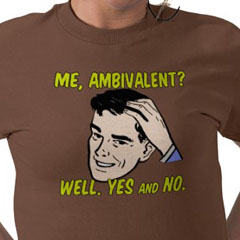Ambivalence is Death
Posted: February 3rd, 2011 | Author: Nathan | Filed under: theory
The audience says "meh" when you say "meh." Image: Arch Wear/Zazzle.
When you’re creating something, nothing kills faster than ambivalence.
I’m not talking about ambiguity. When the viewer or listener comes to your work, it’s OK to be ambiguous. The best art and design only goes halfway: The viewers themselves must ideally step up to the work and actively engage with it (or be engaged by it) in order to leave a significant emotional impact.
This is where a lot of abstract art fails. Too much mystery with too little to draw emotional interest can render the piece inaccessible even to willing viewers, a reaction that many have to the works of Rothko and Pollack, and even the much-maligned Wolff Olins Olympic logo design. Music can do this, too, when compositions are too abstract and even alienating, whether it’s some of the later works of Autechre or the atonal and complex works of Ligeti. But by leaving a few things tantalizingly uncommunicated, the audience can really engage their senses and curiosity to create a lasting impression which they, themselves, have helped create.
Ambivalence doesn’t lie in the work, or in the audience…it comes from the maker of the work. Ambivalence can be the result of making arbitrary decisions for the sake “done.” It can also come from facing an issue with the work and ignoring it or punting on it for later, and never circling back around to it.
In sound, ambivalence often comes from not taking a stand on big issues, like representation versus abstraction. If one scene has a mix of both very literal and very abstract sounds, the viewer may not understand what emotional state the characters are in. A confusing mix of diegetic and non-diegetic sounds – a classic snafu by sound designers who are driven by the coolest sounds, not the most appropriate sounds – can seriously muddle the narrative message. In game design, this can mean the difference between a player being oriented properly in the game world to misinterpreting sound cues that can lead to poor decision making in-game.
You can recognize ambivalence when you say, “tsk, I guess this will be OK.” You can anticipate ambivalence when you hit the point of, “we’ll circle back on this sound later in the mix and see if we can make it better,” but it never happens. You can smell ambivalence when working with clients, producers, or directors who don’t have clear visions for the emotional content of certain moments.
How does one fight ambivalence? One makes a stand. One analyzes the context of the design problems, and creates a framework, theory, or design approach that all decisions can refer back to. One digs one’s heels in and says, “For this use, and in this context, this approach feels emotionally right, for these reasons, and all aural decisions should be based on this framework.”
It’s not all bad news if this decision-making framework fails to produce the right results. If it doesn’t solve the problem, you at least know it’s the core thinking that’s flawed, not the specific sounds you chose. It’s how you’re using the sounds that’s the problem. The great thing about discovering that level of failure is that you can revisit the highest level of the problem and discuss it…this keeps the discussion at a more strategic level, which will help to prevent the client(s) from micro-managing the actual sound design and implementation process. That’s where your expertise comes in, and is most relevant.
Sure, it’s important to be right. But I think it’s more important to have an opinion, early and forcefully, even if it doesn’t work out. Fail early and often, as so many creative professionals suggest. Get your co-workers and clients used to evaluating your approach and thinking than the nitty gritty details of implementation. The former can help “scaffold” your decisions as you revise, whereas critiquing only the latter may not ever resolve the core issues of how sound can support the visual narrative.
Being wrong is better than being ambivalent…as long as you do so early enough that you can reframe the problem and course-correct before the due date.
Tags: art, creativity, design, diegesis, problem solving, sound design | 13 Comments »